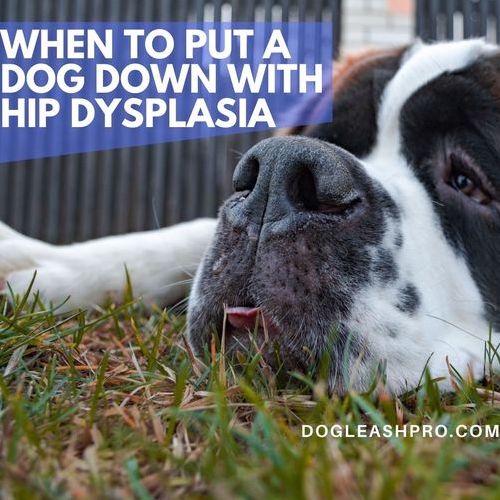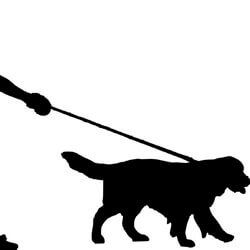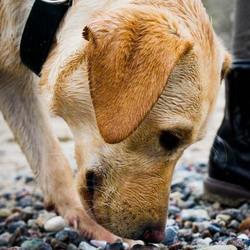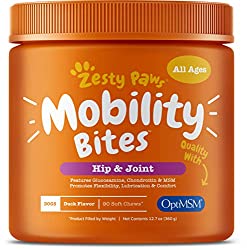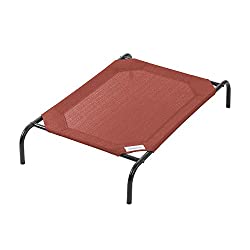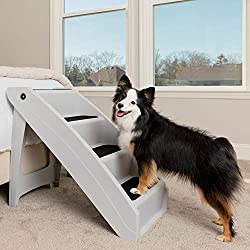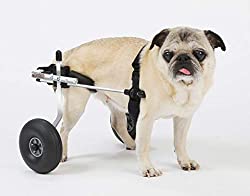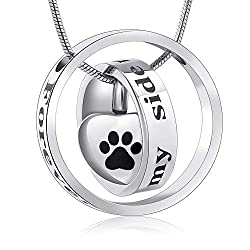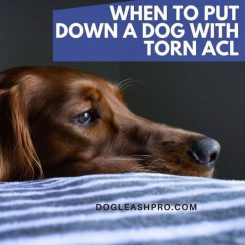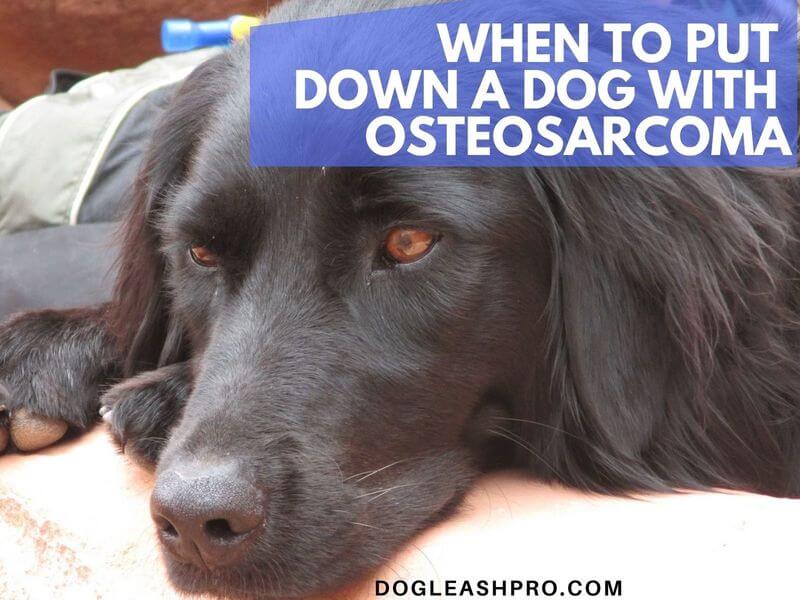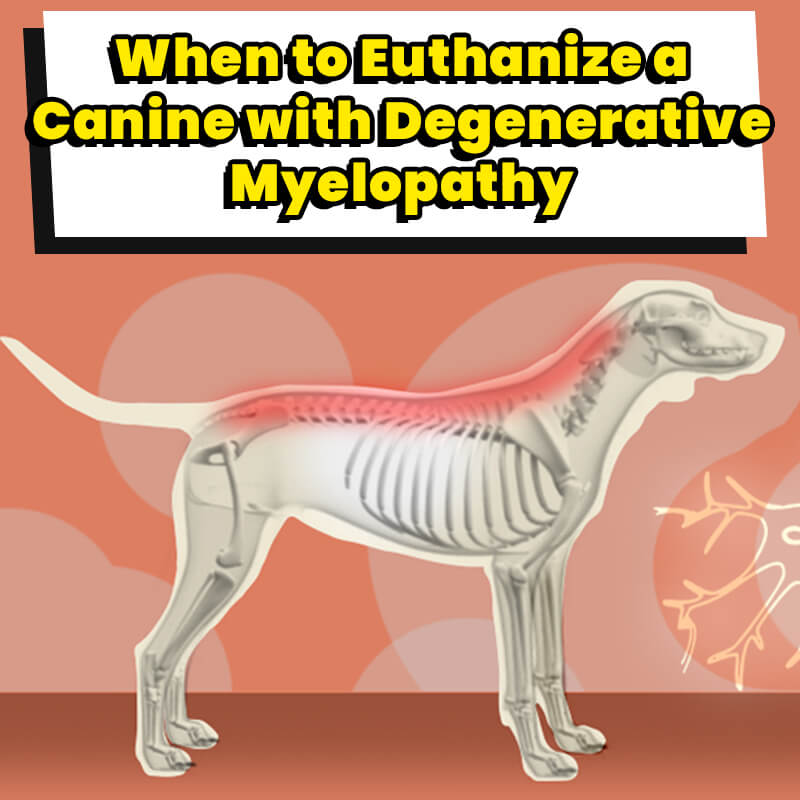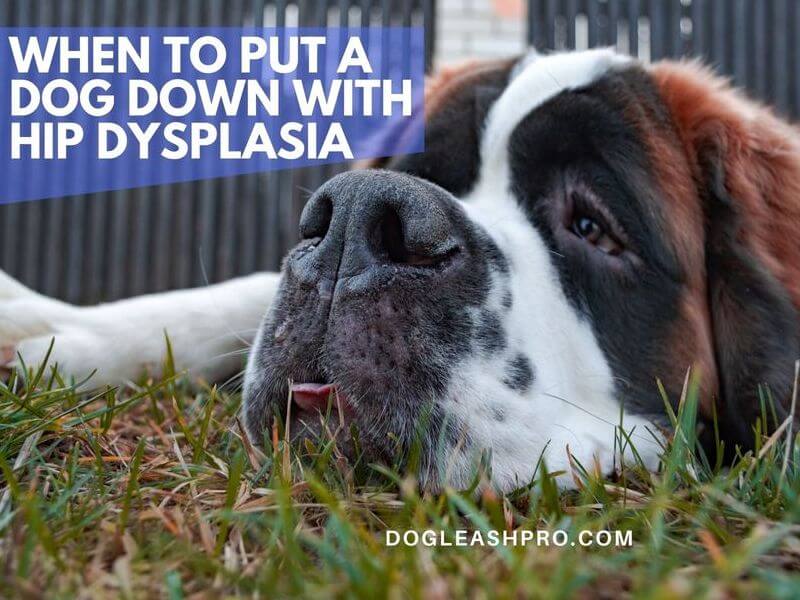
Last year, my uncle’s Saint Bernard puppy was diagnosed with mild hip dysplasia. It started when he was just one year of age. I visited them recently and his pup is doing well. It’s key to note that a puppy with hip dysplasia can still live a happy and fulfilling life. So you may wonder the following question.
When to put a dog down with hip dysplasia? Before making the decision to put a dog down with hip dysplasia, observe their posture, expression, and behavior and consult with your vet. There are several factors to consider including your pup’s quality of life, their mobility, and whether they’re at the end stage of this condition.
Many of the symptoms found in canine hip dysplasia mimic those of other diseases common in dogs, check out our article What is the Right Time to Euthanize a Dog with Osteosarcoma for more information and to rule out other possible conditions.
Based upon my personal experience and many of the vet’s recommendations online, I’ve put together a step-by-step guide on when to put a dog down with hip dysplasia.
Table of Contents
Hip dysplasia in dogs
Hip dysplasia is also known as hip osteoarthritis. While your puppy is growing, the ball (thighbone, or head of the femur) usually grows at the same rate as the socket in the pelvis (acetabulum). Essentially, the hip joint is a ball and socket joint.
When the hip joint isn’t growing at equal rates during puppyhood, then there is a deformity of the hip and hip dysplasia occurs. This developmental disorder is called canine hip dysplasia or CHD.
As a result, there is laxity or looseness of the joint. The dog’s body will then attempt to stabilize the loose hip joint. Hip dysplasia is usually followed by degenerative joint disease or osteoarthritis.
Interestingly enough, some dogs with serious signs of hip dysplasia on X-rays may not show any clinical signs or symptoms while other pups with minimal signs of hip dysplasia may experience lameness or even severe pain.
While hip dysplasia can happen to any size dog or breed, it is most commonly seen in larger dog breeds that are 50 pounds or greater. There are many factors that contribute to this condition including genetics, growth rate, exercise, diet, hormones, muscle mass, and the environment.
Helping you decide when to put a dog down with hip dysplasia
Consider all of your options before deciding to put down your dog with hip dysplasia. Fortunately, there are several treatment options available so your canine friend can live without pain and suffering. Before you make any quick decisions, discuss with your vet or qualified professional.

Total Time Needed :
6
Months
30
Minutes
Total Cost:
65
0 USD – 6500+ USD
Required Tools:
Things Needed?
Steps to decide if you should euthanize your dog with hip dysplasia:
Common symptoms of hip dysplasia in dogs
The clinical signs of canine hip dysplasia is pain and weakness in the hind legs. While it is common to see the following signs of a dog’s hip out of place when they are one to two years of age, it can also happen to puppies as early as a few months old.
You’ll see the following signs and symptoms:
- Unable to rise from a lying or sitting position
- Appears to wobble when standing or limp when walking
- Unwilling to climb up or down the stairs
During early puppyhood, your pooch should visit the vet every 3 to 4 weeks until they are 16 weeks old. These monthly wellness exams allow you and your vet to detect any deformity sooner. During these visits, you can request to have your pooch get x-rays or radiographed.
As you can see, hip dysplasia usually begins in puppyhood and sometimes a pooch with mild hip dysplasia or minimal arthritis will not show any clinical signs or symptoms until they are older. It may take years of gradual bone degeneration before you see any signs.
Early detection is key because mild limping can turn into full paralysis of the legs.
Dog breeds prone to having hip dysplasia
While any dog can be affected by hip dysplasia, larger breeds often suffer from it including:
- Bulldogs
- German Shepherds
- Golden Retrievers
- Labrador Retrievers
- Old English Sheepdogs
- Saint Bernards
Larger mixed-breed dogs are also prone to developing hip dysplasia. If you’re planning to own a large mixed-breed dog or already have one, be sure to give them a specially formulated large breed growth diet during their first year. Consult with your vet to learn what this diet should entail for your puppy.
In some cases through genetic inheritance, small dog breeds like Pugs and Frenchies can also be affected by hip dysplasia.
Hip dysplasia diagnosis
If you suspect that your puppy has hip dysplasia, schedule a checkup with your vet right away. Your vet will put your pup under general anesthesia so they can be radiographed. This will allow the vet to find out if your pooch has this condition. Please note that this procedure should be done as soon as possible.
Additionally, your vet will perform a full body checkup and look for clinical signs and symptoms or visible joint laxity. Upon their review, they will let you know whether your pooch has hip dysplasia or not.
How long can a dog live with hip dysplasia?
Dogs can still live a comfortable normal life well into their golden years even if they have hip dysplasia. This means that it’s not the end of the world if your pup has been diagnosed with this condition.
Go through a few treatment options recommended by your vet. This way the condition doesn’t worsen to “end stage” when euthanasia is strongly considered.
As a pet owner, you can help to manage and treat your furry friend’s pain by providing them the support and care they need. We cover this below. Together, you both can still expect many happy years together.
Treatment options
Depending on the amount of discomfort your pup is in and any clinical sign she is showing, treatment options will vary. Every dog is different so the choice of treatment should be made on an individual basis.
Ask your vet if non-steroidal anti-inflammatory drugs (NSAIDs) such as meloxicam will help your pooch. NSAIDs are very effective and have minimal side effects.
Another treatment option is getting polysulfated glycosaminoglycan injections on a regular basis to inhibit the bad enzymes that break down the cartilage in your pup’s joints.
Physical therapy is another highly effective treatment to help improve your pooch’s quality of life.
If your dog is overweight, your vet may recommend weight loss because excess weight could be putting stress on their hip joints.
Your pup’s body naturally has glucosamine and chondroitin in order to keep the cartilage healthy so veterinarian-approved glucosamine sulfate, chondroitin sulfate, and omega-3 fatty acid nutritional supplements are recommended.
Glucosamine sulfate:
Chondroitin sulfate:
When both of these are taken orally, it may help to increase the rate of new cartilage formation and improve cartilage loss or damage.
Omega-3 fatty acids:
Alternative treatment options
If medical therapy or non-steroidal anti-inflammatory drugs (NSAIDs) aren’t effective for your canine, an alternative treatment option is surgery. Your dog’s vet will recommend a surgical treatment that’s appropriate for your pup based upon her condition, age, and lifestyle.
The good news is that there are several surgical procedures that can treat hip dysplasia.
To treat hip dysplasia in dogs, the two most common surgical procedures are femoral head ostectomy (FHO) and total hip replacement (THR). The surgical cost for FHO is between $1,000 and $3,000. The cost for THR is between $5,000 and $6,500.
There are also other less common surgical techniques to treat hip dysplasia. These include DARthroplasty, juvenile pubic symphysiodesis, and triple pelvic osteotomy (TPO).
How can I help my dog with hip dysplasia?
There are several things you can do now to help your dog with hip dysplasia before considering having to put them down. The following ways will assist in easing their pain and help improve their quality of life.
- Provide a healthy well-balanced diet so your puppy is within a normal lean weight during growth or a diet to help them lose weight. Avoid overfeeding your puppy. This will take the stress away from their hips and help them avoid hip dysplasia.
- Have your canine exercise on soft to medium surfaces like grass and dirt so it is low-impact. Avoid hard surfaces like concrete as walking on that puts a lot of stress and pressure on the hips.
- Physical therapy such as hydrotherapy is very helpful to keep your pooch active.
- Ask your vet if anti-inflammatory medications such as Non-Steroidal Anti-Inflammatory Drugs (NSAIDs) or corticosteroids could help ease the pain and pressure of hip dysplasia.
- Find out if your vet recommends joint fluid modifiers.
- Many vets recommend getting joint supplements with glucosamine or mobility chews. We’ve provided 3 highly recommended joint supplements you can choose from.
- Providing your four-legged friend with an elevated pet bed will help reduce the pressure on their hip and joint when they are relaxing or sleeping.
Exercising every day is still vital. Try low-impact activities such as swimming and walking and avoid high-impact activities like jumping. Daily exercise will keep your pup mobile while also strengthening the surrounding support structures.
Home treatments for dogs with hip dysplasia
To help reduce the pain from hip dysplasia, you can provide the following home treatments as well as changing your pup’s lifestyle. These include:
- Physiotherapy session (ask your vet or a professional for guidance).
- Provide a healthy, lean, and well-balanced diet to help with weight loss. A lean pup can still live a happy, healthy, and long life with hip dysplasia.
- Avoid treats or provide healthier treats like vegetables.
- Heat therapy such as a warm bath can relief any arthritis pain and relax the muscles in your dog’s body.
- Similarly, use heat packs and put it against your pooch’s hip to relax the muscle and relief the pain.
- Hydrotherapy such as swimming will help your pup stay active and mobile.
- Add omega-3 fatty acids to your dog’s food. Studies shows that they help with joint pain relief.
- Because dogs aren’t able to climb up the stairs or hop onto the sofa, it’s best to get a dog ramp to accommodate their reduced ability.
Can a dog walk with a dislocated hip?
Speak with your vet to find out if your dog can still walk with hip dysplasia. The answer will depend upon what stage of hip dysplasia your dog is at.
Many vets recommend walking your dog in moderation on soft-impact surfaces like grass or dirt instead of hard surfaces like concrete or asphalt.
Soft-impact surfaces are sometimes uneven which helps your dog strengthen their muscles, tendons, and core as they walk. It’s best to avoid jumping or running when you’re taking your dog on a walk. Make sure she is on a leash so you have full control of her in case she gets distracted.
If your vet recommends continuing to walk your dog, then it’s best to get either a dog hip brace or a dog harness for hip problems. It gives you full control while providing support for your pup.
Alternatively, ask your vet if using a dog wheelchair will help when walking. It will give your canine the ability to move around and provide the extra support needed so they can live their life to the fullest.
Exercises for dogs with hip dysplasia
If your dog has hip dysplasia, exercise is vital as it builds muscle mass, strengthens the hips, and allows the joints to move more, provided that it doesn’t put pressure on the hip. When the joints move, it helps to lessen inflammation so make sure to walk on soft-impact surfaces.
Low impact activities like swimming are best. Find a canine rehab specialist. They may have an underwater treadmill that allows your dog to walk in warm water to help move the joints with minimal pressure to the hips.
Another exercise to help loosen the hip joints is to have your pup perform the sit and stand exercise. Have your pooch sit and then signal them to come to you. When they do, reward them with a treat. Continue this exercise. Each time, increase the distance between you and your dog so she can take more steps.
While these exercises are helpful, they can also be excruciatingly painful for dogs with end stage hip dysplasia. If this is the case, you may want to choose another way to keep your pooch active and mobile.
Deciding if you should put down a dog with hip dysplasia
Before you consider euthanasia, take note of your furry friend’s quality of life. Here are some questions that will help you decide when is the right time to euthanize a dog with hip dysplasia.
- Is your four-legged friend able to drink and eat properly without your help?
- Can your pup go potty without experiencing hip or joint pain?
- After lying down, is your pooch able to stand up on her own?
- When your pup is sitting, does she collapse right away or after a few minutes?
- When your pooch is walking, are they dragging their hind legs or shifting their weight onto other legs?
- Can your pup breathe easily or is she’s laboring to breathe? How is her mental capacity?
- Is your pup incontinent due to her hip dysplasia condition?
- From your observation, is your pup feeling happy or miserable and uncomfortable?
You can find out by observing their posture, expression, and behaviors. It’s important to continually evaluate your pup’s overall quality of life.
If your dog is immobile such that she can not walk on her own or is not able to go potty without your assistance, then she may be living a poor quality of life. This end stage is when you should consider peacefully putting your pup down to end her suffering.
Speak with your dog’s vet to confirm your answer to these questions. If you answer yes to most or all of them and all treatments (including surgery) have been exhausted, then your vet may recommend putting down your dog with hip dysplasia.
Ultimately, as the owner of your pup, you are the only person that can make the final decision. As one of your family members, you know your pooch best.
How does euthanasia work?
Euthanizing your pup so they can pass away peacefully is the most humane way. If you choose not to euthanize and let nature take its course, then your pooch may pass away with lots of internal pain. For many owners, it’s heartbreaking to witness our pooch in constant pain and suffering.
Some pet owners prefer to have the euthanasia procedure done at home so that the pooch is surrounded by family members.
Others will have to go into the vet’s clinic to have this done. Whether you choose at home or at the vet’s clinic, your vet will handle the entire procedure and answer any questions you may have.
Here’s how dog euthanasia works:
If you have a large dog, she or he will lie down on a table for this procedure. The vet will then administer an injection of sodium pentobarbital (anesthetic drug) with a syringe. This will quickly cause your pup to lose consciousness and painlessly stop the heart.
During this time, you can think back to any fond memories you had with your beloved canine companion and thank them for all the happy memories you’ve shared together. Your vet will inform you of the time of passing by checking for a heartbeat.
This is the last time you’ll see your furry friend but know that they are now free from pain. They left this earth in a painless way and will no longer suffer due to the humane decision you made. Take this time to process the grief.
Remembering your dog
After the euthanization procedure, it may feel like the pit in your heart will never heal. Know that sadness will come in waves and it will take some time to process and move forward from the loss.
You can choose to have either a cremation or a traditional burial.
Many dog owners choose to cremate their beloved furry friend because this allows them to keep the remains in their house within an urn. Some prefer a traditional memory box while others like the necklace option. The urn below allows you to customize it with your favorite memories or quotes.
Pet Insurance
No matter which treatment option you choose for your four-legged friends, the truth is that pet health can be costly especially if you’re not prepared. If you choose the surgery route without pet insurance, that can also put a hole in your wallet.
Even regular vet visits and x-ray exams can get costly.
This is why we highly recommend getting pet insurance. An insurance policy plan can reduce some of the financial burdens since the plan can cover some of the medical expenses. It can also keep the monthly payment fairly low and give you peace of mind.
Choose a pet insurance that offers full-term policies that are customizable so you can choose how much you have to pay each month.
It’s best to get pet insurance before you need it. You never know when your dog may suffer from hip dysplasia. In the event of an emergency, it will help you pay for your dog’s surgery or treatment.
Unfortunately, many dog owners may not be prepared with pet insurance and the treatment or surgery is way too expensive for them. Due to this, their only option is to put down their dog with hip dysplasia so their pup no longer has to suffer or live in constant pain.
So don’t wait, get your pup covered as soon as you can.
Conclusion
The decision to put down your dog with hip dysplasia will be one of the most difficult decisions of your life. But euthanizing your beloved furry friend to end their suffering far outweigh the constant pain they would have endured.
You are not alone in this. If you have any questions or concerns, it’s best to consult with your vet. Veterinary professionals are there to provide additional guidance and advice.
Keep an eye on your canines and observe their quality of life, walking gait, mood, and behavior. Speak with your vet and ask for help. We feel your pain and during this time, I send you my best wishes. I wish peace and comfort for all of you and for your pups.
DISCLAIMER: THIS WEBSITE DOES NOT PROVIDE MEDICAL ADVICE
The information, including but not limited to, text, graphics, images and other material contained on this website are for informational purposes only. No material on this site is intended to be a substitute for professional veterinary advice, diagnosis, or treatment. Always seek the advice of your veterinarian or other qualified health care provider with any questions you may have regarding a medical condition.

With over five years of specialized experience as an animal writer, my expertise lies in dog nutrition, health, behavior, grooming, and training. I am dedicated to delivering helpful and informative content that caters to the well-being of our furry friends. My primary goal is to empower pet owners with knowledge and ensure our canine companions thrive in health and happiness. In my free time, I love volunteering at local dog rescue centers.
